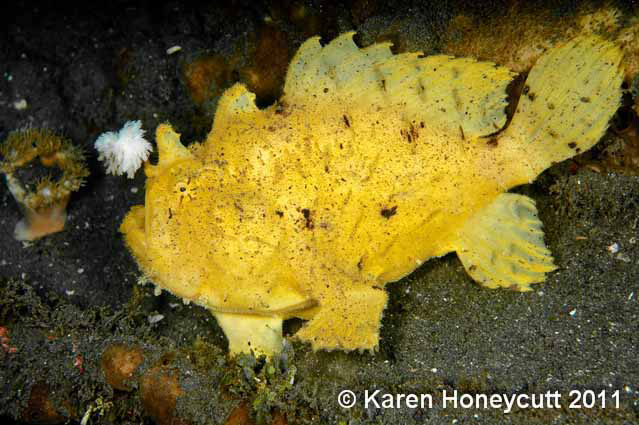Shaggy Anglerfish, Antennarius hispidus (Bloch & Schneider 1801)

A Shaggy Anglerfish, Antennarius hispidus, at Minahasa, Indonesia. Source: Karen Honeycutt / FishBase. License: All rights reserved
Shaggy Anglerfish vary in colour, ranging from white, cream, beige, yellow, orange to black, often with zebra-like bands. They have a white 'pom-pom'-like lure and skin filaments scattered over the body and fins. Fabulous footage of a Shaggy Anglerfish at Ambon, Indonesia.
Shaggy Anglerfish, Antennarius hispidus (Bloch & Schneider 1801)
More Info
|
Distribution |
Widespread in the tropical Indo-west Pacific, from East Africa to Fiji, north to Taiwan and south to Australia. Shaggy Anglerfish are known in Australian waters from the Northwest Shelf, Western Australia, and from the Gulf of Carpentaria eastwards and south to about Sydney, New South Wales. They live in quieter areas on shallow rocky and coral reefs to deeper muddy habitats, often amongst leafy debris in depths to 90 m. |
|
Features |
Meristic features: Dorsal fin I + I + I, 12 (rarely or 13); Anal fin 7; Pectoral fin 10 or 11. First dorsal spine (illicium) about same length or longer than second dorsal-fin spine, esca with a large oval-shaped tuft of numerous slender filaments; 3rd dorsal-fin spine curved posteriorly; caudal peduncle similar in length to second dorsal spine. Skin covered in close-set bifurcated spinules, with numerous scattered filamentous appendages. The arm-like pectoral fins are prehensile; pelvic fins with a short, slender spine and 5 soft rays. |
|
Size |
To 18 cm. |
|
Colour |
Colour variable, light yellow to brownish orange, with dark stripes or elongate blotches all over. In preservative, colour variable from beige, light yellow, orange, dark yellow brown to black. Filaments arising from anterior surface of esca often darkly pigmented; illicium banded. Lighter-colour phases with 6-8 (range; 0-10) darkly pigmented streaks radiating out from eye; belly without elongate streaks, sometimes with scattered, dark, circular spots. |
|
Feeding |
These well-camouflaged ambush predators feed mostly on fishes. They lie motionless, moving only their lure erratically in front of their mouths in a triangular pattern to resemble tubeworm tentacles waving in the current. Unsuspecting prey attracted to the lure are rapidly engulfed into the large mouth. |
|
Biology |
Reproduction: Oviparous, sexes separate with external fertilization. Pelagic eggs are laid in a gelatinous floating mass or 'raft' where they remain embedded until hatching. One raft measured 2.9 m by 0.16m. Pelagic larvae spend the first 1 or 2 months in the plankton before settling onto the reef. |
|
Fisheries |
Although of no interest to fisheries or aquaculture, Shaggy Anglerfish are occasionally taken as bycatch in commercial fisheries, and are sometimes collected for sale in the aquarium industry. |
|
Conservation |
|
|
Similar Species |
Although Antennarius hispidus is most similar tothe Striate Anglerfish, Antennarius striatus, it has a 'pom pom'-like esca, rather than the worm-like appendages on the lure of A. striatus. |
|
Etymology |
Antennarius is from the Latin, antenna, meaning sensory organ on the head, in reference to the modified first dorsal spine forming a lure. |
|
Species Citation |
Lophius hispidus Bloch & Schneider 1801, Systema lchthyologia: 142. Type locality: Bay of Bengal, India. |
|
Author |
Dianne J. Bray & Vanessa J. thompson |
Shaggy Anglerfish, Antennarius hispidus (Bloch & Schneider 1801)
References
Allen G.R. (1997) Marine Fishes of tropical Australia and South-east Asia: A field Guide for Anglers and Divers. Western Australia Western Australian Museum 292pp
Hoese DF, Bray DJ, Paxton JR & Allen GR (2006). Fishes. In Beesley PL & Wells A (eds) Zoological catalogue of Australia. Volume 35 ABRS & CSIRO Publishing: Australia Part 1, pp xxiv 1-670; Part 2, pp xxi 671-1472; Part 3 pp xxi 1473-2178
Michael, S.W. (1998). Reef Fishes Volume 1. A Guide to Their Identification, Behaviour and Captive Care. Microcosm Ltd. Shellbourne, Vermont 624 pp.
Pietsch T.W. (1984). The genera of frogfishes (Family Antennariidae). Copeia 1984(1): 27-44.
Pietsch, T.W. & Grobecker, D.B. (1987). Frogfishes of the World: Systematics, Zoogeography, and Behavioural Ecology. Palo Alto: Stanford University Press, 420 pp.
Randall J.E. (2005). Reef and Shore Fishes of the South Pacific. University of Hawaii Press, Honolulu. 707pp.








